To continue this work from a different angle while finding new answers to old questions about heads of school, aspiring heads, and what’s keeping them on their paths through headship––or pushing them off course––NAIS again fielded the "State of Independent School Leadership Study" this past spring. Six hundred and twenty-two heads of school and 635 administrators of various positions responded to the two separate surveys that constituted the 2021 edition of the study. Informed by recent work as well as the COVID-19 pandemic, the full 2021 report examines head of school and aspiring head of school demographics; school support systems, satisfaction, and leader health and well-being; self-confidence and professional development needs; and career paths and plans. Among the report’s findings, four key themes emerge that offer important perspective.
More school administrators want to be heads. In 2009, just 21% of administrators were interested in becoming heads of school. In 2021, that share has risen to 31%. Among administrators who are not interested in headship, two-thirds aspire to higher leadership positions in independent schools or have already moved up the ladder.
More aspiring heads identify as people of color and LGBTQ+ people than do other administrators. Additionally, more aspiring heads are people of color and women than aspiring heads were in 2009. Twenty-three percent of aspiring heads identify as people of color, up from 14%, while 55% identify as women, over 20 points higher than in 2009. An additional 13% identify as LGBTQ+.
Composition of Aspiring Heads and Other School Leaders by Race/Ethnicity, Gender, and LGBTQ+ Identity in 2009 and 2021
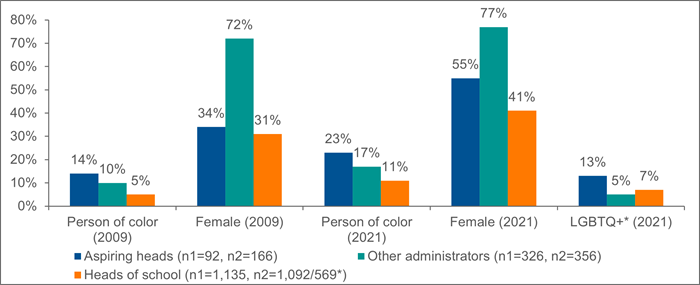
*Respondents were only asked about LGBTQ+ identities in 2021. Head of school race/ethnicity and gender data come from DASL.
Source: 2021 State of Independent School Leadership, Chapter 2: Who Wants to Be a Head of School?
Most aspiring heads are following a “traditional” path to headship, filling assistant or associate headship roles. Fifty-six percent of all current assistant and associate heads aspire to headship, and they comprise 37% of all aspiring heads in the sample. An additional 56% of upper school heads and 52% of middle school heads aspire to the headship, as do 55% of deans of faculty. However, DEI practitioners are also interested, with 59% of current DEI officers aspiring to headship. Schools have much budding talent throughout their ranks, and it’s crucial that they develop and consider all aspiring leaders, even if they aren’t on the traditional path.
Administrative Positions with the Highest Proportion of Aspiring Heads
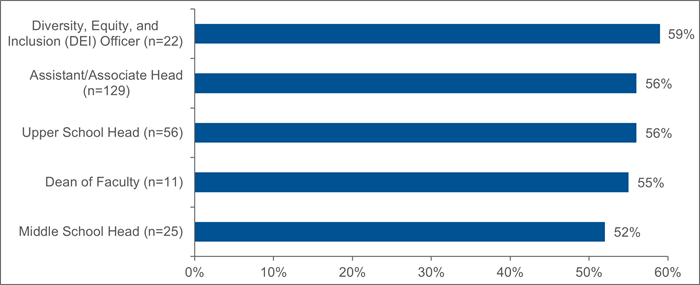
Source: 2021 State of Independent School Leadership, Chapter 2: Who Wants to Be a Head of School
Fewer school leaders think that being a head is worth the stress. Only 73% of heads of school believe that their job is worth the stress most or all the time, down from 86% of heads in 2009. That number is lower for women and people of color, with only two-thirds of them agreeing.
Being the Head of an Independent School is [Well] Worth the Stress All or Most of the Time
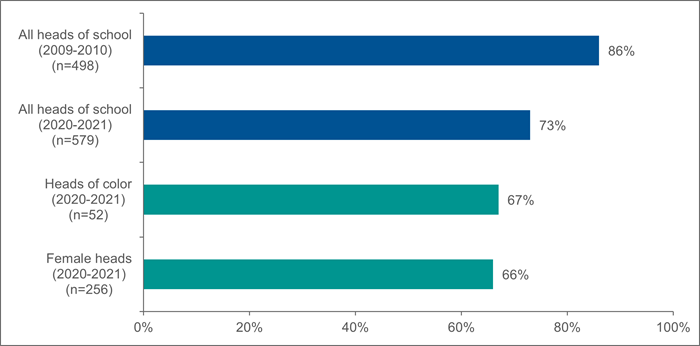
Source: 2021 State of Independent School Leadership, Chapter 3: How Are School Leaders Doing?
NAIS had previously found that many heads feel independent school headship became more difficult and time-consuming after 2010, with most struggling to balance their personal time with always-on communication and school needs. This is, not surprisingly, a major issue among heads: More than 60% report that they’re unsatisfied with the amount of free time they have for themselves and their loved ones—compared with about 45% of administrators. An additional 64% of heads report feeling dissatisfied with the increased pressure, stress, and isolation as a school leader.
Heads and administrators feel supported, but they need more targeted support to excel. School leaders, and particularly heads of school, have had a lot on their plates over the past school year and likely will in the year to come. Luckily, most do report having strong support systems. More than 80% of heads are satisfied with the support they receive from their board, board chair, and fellow heads of school, while three in four administrators are satisfied with their school’s support of their mental and physical health needs.
Of course, that leaves around 25% of administrators feeling dissatisfied with the well-being support they receive, meaning a number of schools need to consider what else they can do to help their school leaders thrive. Similarly, 31% of heads of school are dissatisfied with the support that their family receives from their school.
Heads of school are overall confident that they are prepared and have the skills they need to lead their schools.
However, there are many areas where a majority of indicate that they do not feel very prepared, instead assessing themselves as only “somewhat” prepared or even “somewhat” or “very” unprepared. These areas of lower confidence often mirror the self-assessments of aspiring heads, who overall feel less prepared than their sitting peers.
Sitting and aspiring heads feel unprepared to handle financial issues, with only 48% of sitting heads and 15% of aspiring heads feeling very prepared to manage their school’s financial health, while just 40% and 19% feel prepared to fundraise, respectively. Human resource and legal issues also pose a challenge for school leaders, with about three in five feeling not very prepared for the former and 65% of heads and 78% of aspiring heads feeling not very prepared for the latter.
Tasks Where Less Than Half of Heads of School Feel “Very Prepared,” Compared to Aspiring Heads
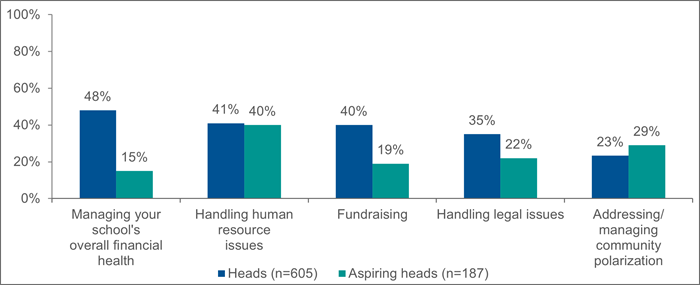
Source: 2021 State of Independent School Leadership, Chapter 4: Where Do School Leaders Need Additional Training and Support?
Expect leadership turnover over the next five years. Fifty-five percent of heads of school expect to leave their current position within the next five years. Although 29% of these heads were still unsure of their next steps, 33% intend to retire, while 28% intend to change schools. Just 11% intend to leave the school sector entirely.
Similarly, 61% of administrators also expect to leave their current positions within the next five years. Of that group, 29% intend to retire, 25% intend to work in a nonteaching job, and 11% say they’ll switch schools. Twenty-one percent intend to stay a full five years and did not indicate other plans, while the rest specified other options.
Looking Forward, Would You Say You Plan to Transition From This [Administrative] Job?
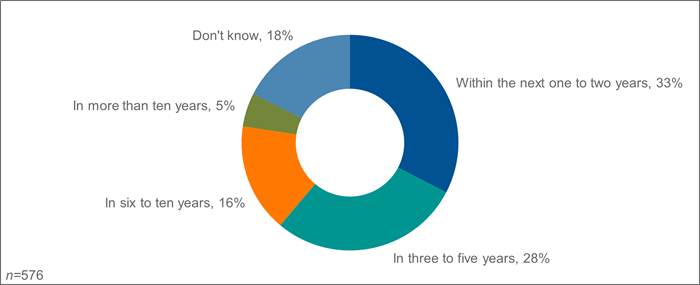
Source: 2021 State of Independent School Leadership, Chapter 5: Where Are School Leaders Going Next?
Many school leaders are tired after dealing with the pandemic, however that may have looked for them. While many pandemic-era predictions of educator turnover have yet to come true, there is precedent to heads leaving when they say they will: In 2009, 37% of heads intended to leave their schools within the following five years, on the tail end of the recession. Between 2010-2011 and 2014-2015, 48% of NAIS schools experienced head of school turnover.
Although only 28% of all heads had their long-term transition plans affected by the COVID-19 pandemic, 54% of those leaving within the next five years have changed plans because of it: 27% decided to leave sooner, while just 9% were staying longer (and 18% were unsure). More administrators were affected by the pandemic than heads, with 23% reporting a new timeframe for their career plans, 15% unsure about their next steps, and 5% making new plans entirely.
Women, LGBTQ+ people, and people of color were more likely to report having their career plans affected by the pandemic. The differences were particularly stark for heads of school, with heads of color 9 percentage points more likely, female heads 17 percentage points more likely, and LGBTQ+ heads 18 percentage points more likely to have been affected by the pandemic than their white, male, and non-LGBTQ+ peers, respectively.
Percentage of Heads by Demographic Whose Plans Were Affected by the Pandemic
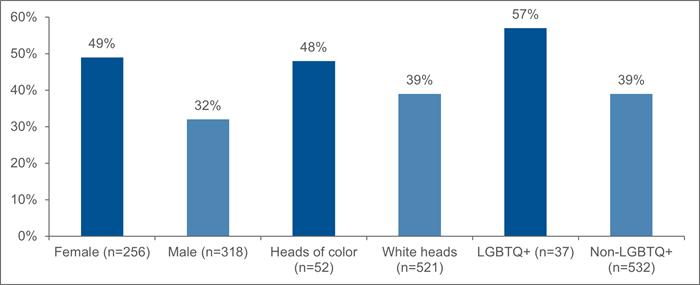
Source: 2021 State of Independent School Leadership, Chapter 5: Where Are School Leaders Going Next?
Much has changed since NAIS last fielded the “State of Independent School Leadership” survey, but the dedication of school leaders has remained steadfast. Despite the many challenges facing independent schools today, the 2021 survey has made it clear that there is a willing, capable cohort of emerging and existing leaders who are ready—and are already—leading their schools into what comes next.